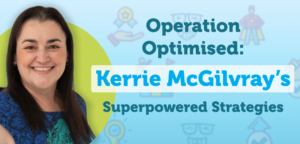When it comes to running a more efficient business, there are some things you can be doing in-house that can significantly improve your operations. Josh spoke to Greg Gunther from Your Business Momentum about one of the best days to do so – systematising your business.
What Does Systemising Your Business Mean?
Systemising can mean a lot of different things to different people. Often they might think it’s my tech stack or which software I use, but in the context of the way we talk about systemising, it’s really about identifying the repetitive tasks that need to get done on a regular basis. They’re often done in the same way. You can point to around 85% of the things that we do inside a business are quite repetitive. It might be things like invoicing or it might be producing a particular widget, but the steps in creating that are usually the same.
What we find a lot in businesses is it’s in people’s heads. We want to be able to produce predictable results. Obviously, there’s a quality control around that as well. It makes sense to just really start to think about identifying the steps and what would be the ideal way for us to take an import of A, do all the things we need to do with it through processes to create B?
Where to Start?
What I always say to people is start with what you’re already doing. It might not be the most efficient, but at least if you start capturing what you’re already doing, it gives you that baseline to work upon. Processes will always evolve because technology changes or there might be a particular element that we’re using in the process that might change with time, which requires us to use a different process. We always need to be able to have an overarching system that says we are continually improving what we’re already doing. Culturally, that needs to be embedded into our business. We need to think about is there a better way?
One of our core values is there’s always a better way. That’s something my father instilled in me from a very early age. I think that holds true. If we’re always interrogating or looking curiously at what we’re doing and asking ourselves that question, it’s a good chance that we might identify an efficiency gain that we could pick up. There will always there will be anywhere from 15-30% inefficiency in the way we do things. These are all the things that we want to weed out. Once we’ve got a baseline to start from, that then gives us that visual anchor to look at and say, is there a better way that we could do that? That’s when we start to pick up the efficiency.
Ready to take your business to the next level? Start systematising today and unlock the true potential of your operations.
Documenting Your Processes
The way we want to make sure that we’re documenting things is in such a way that people can follow. It should be literally down to step one, do this, step two. A common mistake we see is when people want to process an invoice, they’ll jump straight to Xero and they haven’t logged in yet. One of the things that we like to work with people on is having that facilitated approach, because if we were to document it ourselves, chances are we’re going to miss a lot of steps. The test of a process documentation is if somebody else like I, for example, who had nothing about your business, Joshua, would come in and pick up a particular process, you give me an instruction to do something for you, and I can just find the process easily and literally step it through and it works.
Documenting needs to be quite a cultural, continuous improvement mindset that we need to embed in our businesses. Obviously, that needs to be led from the top. But we need to be encouraging people all the time, just curiosity. Is there a better way to do that? And if there is, we need to have a process that allows them to come up and say, Look, I’ve got a better way of doing that. Can we actually review that particular process and come up with a better way?
Poor Onboarding Process = Loss of Talent
One of the most important processes you can ever document is your onboarding process, because it’s the time when we are there hopefully going to get people fast tracked into taking.
Research show that the most common reason people leave a business is that they had a very poor onboarding process. They were just thrown into the deep end. We would argue that an onboarding process needs not just to be their first week or two. We would suggest it’s even three to six months. It’s through their probationary period. It should be self-driven. If you’ve got a really good onboarding process, people will drive it themselves. They’ll just check in every week with whoever is supervising or working with them. There’s a checklist. How did that go? There’s things that we need to improve, which is what you’re referring to, and we can consistently improve.
Transform your business for greater efficiency and success. Embrace systematisation now and elevate your operation. Let’s get started.
How to change mindset?
Often people see documenting processes as being something that’s a threat to them. It’s the “what’s in it for me”. The moment you start to lift the lid, just start to create a bit of capacity for them to do other things, we get to see them in a different light. There’s often things that surprise you that they’re really good at or they have an interest in, that we’re creating some capacity for them to be able to do. Having processes in the underlying running of our business frees up people to be able to do those things.
How might we be able to get to a point where we could give you more of that in your business? You’re just turning it around, something into what’s in it for me.
We’re employing the person. I love the way you look at the parts of their life because that’s a really great insight as to where their interests are, because that’s what we do. We’re not creating a robot. We actually want to employ the person, and that person comes with the complete set. What I’m doing in my private life probably is something of interest to me that I could have skills to contribute towards the business. If we can encourage that, you’re creating a culture where I’m happy at work. That’s the whole grow. We want to have a culture where I want to come to work. I’d tell the whole grow I’d do this for nothing if I had to.
There are ways and solutions to improving the way we do business and living a better life. It’s just that often we don’t have the time or the know-how, or the know-how of how do we actually do that. There’s a lot of different solutions out there. We just need to find them.
Testing Your Processes
If you can physically leave your business for three months and then even another block of three months, that’s an absolute litmus test as to how good your processes are. I think it sounds like you had the finger on the pole. You also had the systems there to support you in terms of knowledge that maybe there was the leading indicators that you had that would trigger, hang on a minute, there might be something going on here, so you can be onto that. As owners, we need to be able to have that high-level, what are the performance indicators that are telling me ahead of time that maybe something’s a drift and we can get onto it early.
Embrace the power of systematisation now! Unleash efficiency and growth with proven strategies.
Map Your Customer Journey
A lot of people don’t even know what their customer journey is. How do our customers find us, for example? Is it a website or is it particular blogs or referrals, introductions? But when we get that first contact with them, what’s the process for that? Just really stepping right through that to the point of delivery and accounts, because the thing when you map a customer journey that it identifies is you’ve got all of these touch points. They’re moments of truth. Because every time I have an interaction with your business, I’m forming a view as to how good that experience was. Most people, when they’re asked about a particular business, will form an assessment around the whole experience. We want to know all of the parts of that are contributing. That’s where I would start. I would think about where on that customer journey do we feel like we’ve got the most weakness?
The Traffic Light System
I just like to keep it simple and use a traffic light type system. Where we’ve got Reds, they would sift to the top as being where we would start, particularly if they’re critical. If you can visualise a matrix, you can think about how well do we do that and how critical is that to my business.
The Pareto Principle
The other good rule that some people might be familiar is the Pareto Principle, the 80-20 rule. Think about what are those 20% of critical processes. They probably answer 80%, so start there. Then developing your systems processes is a journey. It’s often referred to as like painting the Sydney Harbour Bridge. Remember Paul Hogan years ago used to talk about, when you get to the end you have to go back to the start again. System development is like that. We need to continually be looking at what’s coming next. It has to continue to evolve and continue to live. And when you don’t, that’s when the ball starts to drop and then it will fall off again. Learn How to Use the 80/20 Rule to Your Advantage as a Business Owner.
Ready to streamline your business for success? Start systematising today!
Using Net Promoter Scores
There’s a thing called a Net Promoter Score, and that’s something we encourage people to use because it’s been well researched. It’s very simple. One of the problems that people have putting out surveys to clients is a lot of them will not fill it out. But a net promoter score, just ask one question, how likely is it that you would refer a family member or a friend to do business? Because that’s an easy yes or no. 9’s and 10’s really liked it. 7s and 8s, they’re happy with what we’ve done, but they’re what we call passive. The sixes or less are the detractors. That means that something’s gone wrong in their experience. They are the people that we’re really keen to get onto and connect with because they’re the ones that are contentious. They’re the ones that we can learn from.
How Greg Can Help
There’s a couple of things I have that people might find helpful: a system for creating systems. If people want to get a little closer to understand where they sit as an organisation I’ve got a good little quiz that people could do too. It’s just 20 questions, but it’ll give you a report back. The thing that I like about it is, again, Red, Amber, Green, it’ll give you the Red, Amber, and the Green based upon the responses that you’ve given to the questions.





























